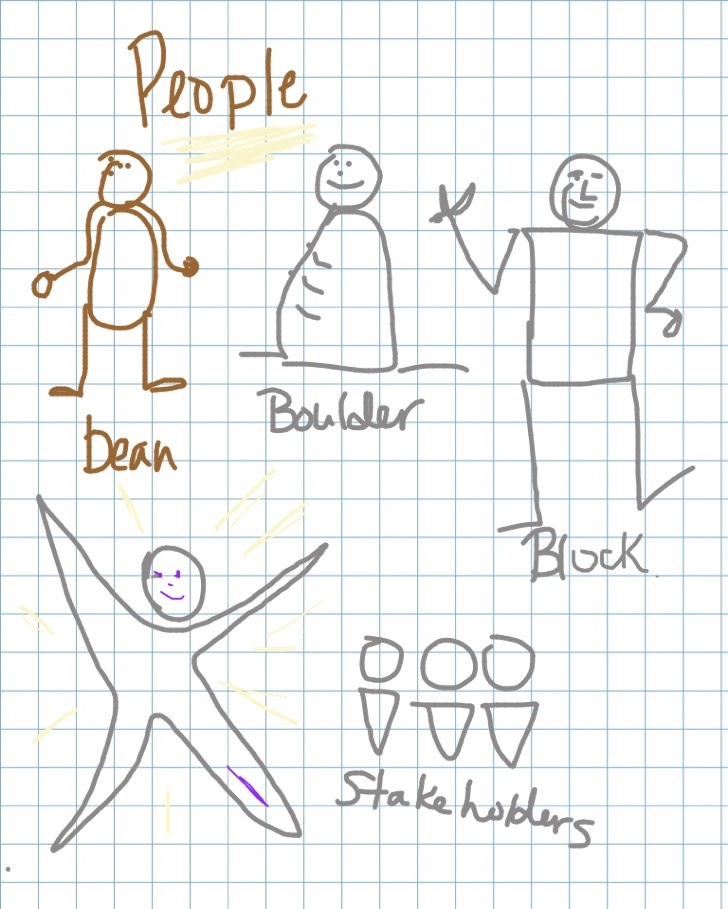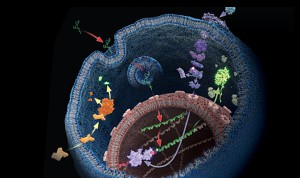When I was in the lab, we usually started with an elaborate system of borrowed hairdryers and old chemistry ring stands. What is your preferred method of attacking a frost-full freezer?
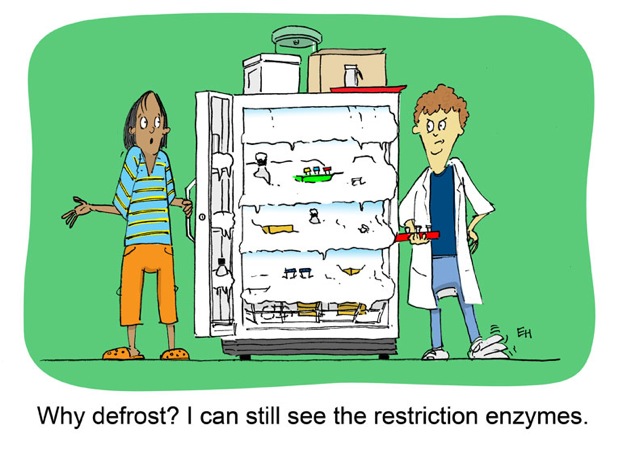
Author: Promega
Monday SMILE
Monday lab meeting? Journal club? Long weekend in the lab?
Enjoy this classic from the Promega Cartoon Lab.
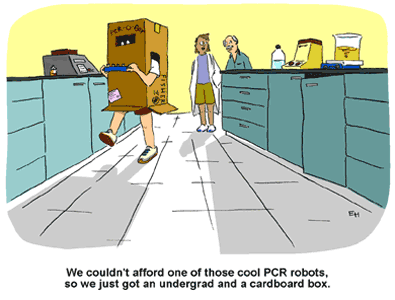
Happy Holidays from Promega Connections
 Your Promega Connections Bloggers will be taking a break from December 23, 2014–January 5, 2015, to retool and gather up our thoughts so that we can cook up New Year of intriguing science posts. You can look forward to posts about bioluminescence, cytotoxicity and cell culture, kinases and cellular signaling networks, epigenetics, and the new twists and turns in biotechnology that are making their way into our labs and our lives. We will continue our tradition of posts to guide the job seekers and those of you in career transitions, and of course we will provide lots of technical tips and tricks for your work at the bench.
Your Promega Connections Bloggers will be taking a break from December 23, 2014–January 5, 2015, to retool and gather up our thoughts so that we can cook up New Year of intriguing science posts. You can look forward to posts about bioluminescence, cytotoxicity and cell culture, kinases and cellular signaling networks, epigenetics, and the new twists and turns in biotechnology that are making their way into our labs and our lives. We will continue our tradition of posts to guide the job seekers and those of you in career transitions, and of course we will provide lots of technical tips and tricks for your work at the bench.
If you have any burning technical questions or a science or technology topic on which you would like to see a post, let us know in the comment section below.
Be sure you are subscribed to the RSS feed so that you can join us on our blogging journey in 2015.
Happy New Year!
NO! I CAN do that.
 Today’s blog is written by guest blogger Jessica Laux, a production scientist at Promega Corporation. Jessica spends most of her time in clean rooms. She graduated from the University of Wisconsin-Madison with a B.S. in Natural Science-Animal Sciences.
Today’s blog is written by guest blogger Jessica Laux, a production scientist at Promega Corporation. Jessica spends most of her time in clean rooms. She graduated from the University of Wisconsin-Madison with a B.S. in Natural Science-Animal Sciences.
I was always a very stubborn, defiant child. This is evidenced by the fact that my very first word was “NO!”, which I screamed at the top of my lungs after I had been scolded for pulling all the pots and pans out of the kitchen cupboards. Years later, I still scream “NO!” at times, though I’ve refrained from making a mess of the kitchen lately. That same defiant spirit contributed a great deal to my chosen career.
At a ripe age of ten, I determined I was destined to become a great doctor. My preparation for this career involved writing morbid stories where I brought the dead back to life, as well as poring over the pages of a medical diagnostic book I had claimed as mine. I was not deterred by my inability to understand the big words. I was still able to draw the detailed human anatomy and skeletons with an impressive precision. A couple years later, an adult whom I trusted told me that science and medicine were fields for men only. This same person encouraged me to pursue my artistic talents instead. Continue reading “NO! I CAN do that.”
Genome Editing and Reporter Technologies Enable Endogenous Pathway High-Throughput Assays
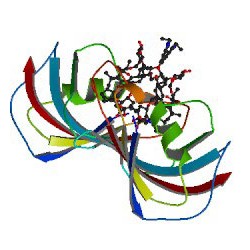
This article review was written by guest author, Amy Landreman, in the Cellular Analysis and Proteomics Group at Promega.
Charcot-Marie Tooth (CMT) disease is one of the most common inherited neurological disorders affecting approximately 2.8 million people worldwide. The most common form of CMT, CMT Type 1A, is caused by a 1.5Mb genomic duplication on Chr17 that results in trisomy of the critical myelin gene Peripheral Myelin Protein 22 (Pmp22). The extra copy of Pmp22 results in excessive PMP22 protein causing the neurophathy associated with CMT type 1A. Although there is no way to remove the extra copy of the gene, even subtle decreases in Pmp22 expression have shown promise against this inherited neuropathy in laboratory models.
In a recent paper, Inglese et al. 2014, describe an interesting new approach used to identify compounds that effectively decrease Pmp22 expression using a novel gene editing strategy and reporter-based screen. Their challenge was to create an assay that accurately represented endogenous Pmp22 expression including both transcriptional and post-transcriptional regulatory mechanisms, while maintaining the sensitivity required to detect subtle changes in expression in a loss of signal assay in a format compatible with microtiter 1536-well quantitative high-throughput screening (qHTS). Continue reading “Genome Editing and Reporter Technologies Enable Endogenous Pathway High-Throughput Assays”
Friday Fun on the Blog
As we start a new year in our labs, we thought this cartoon reminding us of some lab etiquette might be useful. Enjoy!

Choosing the Right Cell Health Assay
Based on the Illuminations article by Dr. Terry Riss, from our Cellular Analysis group.
Choosing the most appropriate cell health assay for your experiment can be difficult. There are several factors to consider when choosing an assay: the question you are asking, the nature of your sample, the number of samples being tested, the required sensitivity, the nature of the sample, the plates and plate readers and the reagent costs.
What question are you asking?
The first, and perhaps most important factor to consider, is the question you need answered. What do you want to know at the end of the experiment? There are cell health assays available that specifically detect the number of living cells, the number of dead cells, and for assessing stress response mechanisms or pathways that may lead to cell death. Matching the assay endpoint to the information you need is vital to choosing the appropriate cell health assay.
Continue reading “Choosing the Right Cell Health Assay”Why We Care About Glycosyltransferases
Today’s post is a guest blog from Michael Curtin in the cellular analysis and proteomics group at Promega.
Glycobiology is the study of carbohydrates and their role in biology. Glycans, defined as “compounds consisting of a large number of monosaccharides linked glycosidically” are present in all living cells and coat cell membranes and are integral components of cell walls (1). They play diverse roles, including critical functions in cell signaling, molecular recognition, immunity and inflammation. They are the cell-surface molecules that define the ABO blood groups and must be taken into consideration to ensure successful blood transfusions. (2).The process by which a sugar moiety is attached to a biological compound is referred to as glycosylation. Protein glycosylation is a form of post-translational modification, which is important for many biological processes and often serves as an analog switch that modulates protein activity.The class of enzymes responsible for transferring the sugar moiety onto proteins is called a glycosyltransferase (GT).
GTs can be divided into three major types based on their roles:
- Oligosaccharide elongation for peptidoglycan biosynthesis
- Regulation of protein activities by post-translational modification
- Small molecule glucuronidation as means of drug metabolism
Get More Out of Your Lentiviral Production
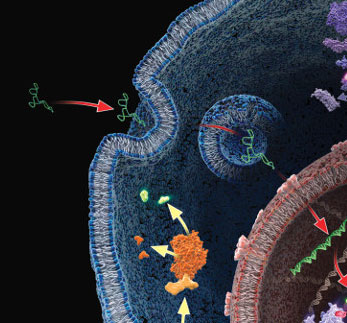 This review is a guest blog by Amy Landreman, Product Specialist in Cellular Analysis at Promega Corporation.
This review is a guest blog by Amy Landreman, Product Specialist in Cellular Analysis at Promega Corporation.
Lentiviral vectors (LVV) have become a valuable research tool for delivering genetic content into a wide range of cell types. Commonly derived from the HIV-1 genome, LVV have the advantage of being able to infect both dividing and non-dividing cells. They can be particularly valuable for introducing genetic material into cell lines that are difficult to transfect using other methods and are also being used in gene therapy applications.
Unlike other gene delivery tools, transducing mammalian cells with LVV requires significant upfront effort since the LVV particles carrying the desired genetic content first need to be created. In general this involves co-transfecting a packaging cell line, such as HEK293T, with a set of three to four separate plasmids that encode the protein content required to generate the LVV particles: the transfer plasmid, which contains the transgene of interest, a packaging plasmid, and an envelope plasmid. After co-transfection, the packaging cell line is allowed to incubate for a couple of days during which time the LVV particles are produced and accumulating in the culture supernatant. The supernatant containing the recombinant LVV is then harvested and, following several concentration steps, the LVV particles are ready to be used for introducing the desired genetic content into the mammalian target cells. Continue reading “Get More Out of Your Lentiviral Production”
Promega Connections: The Year in Review
Your Promega Connections bloggers had a great time bringing you cool science stories, technical tips and assorted other reading material this year, and we want to say a big “Thank you!” to all of our readers for your time, your comments, and your reblogs.
Here are some of the highlights from 2012.
